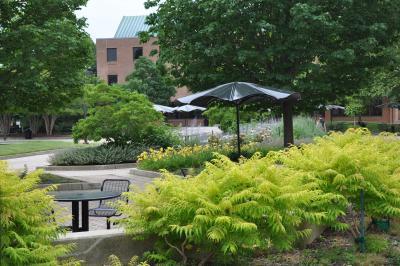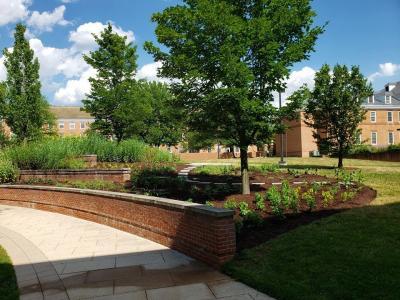Mindful Moments Walking Tour
Our entire campus is a world-class arboretum. With this self-guided tour, we invite you to ground yourself in our garden and outdoor spaces. Use the prompts below to locate and participate in seeking a deeper connection to our campus and yourself. These prompts can be completed in any order, in any amount of time, however much or little you have. Do them individually or as a group to foster a connection and create communication prompts.
This invitation to reflect and connect with our open spaces is brought to you by the Arboretum & Botanical Gardens, the Faculty and Staff Assistance Program, and the Health Promotion and Wellness Services of the University Health Center.
This mindfulness journey takes approximately 45 minutes to complete and may bring about a range of emotions or physical sensations. If you feel overwhelmed or uncomfortable, it is ok to pause and take a break. If you feel you need additional support, faculty & staff members can contact the Faculty & Staff Assistance Program at 301-314-8170 or 301-314-8099. Students can contact the University Health Center at 301-314-8106.

Sit down on the bench or in the grass, wherever you feel most comfortable. Take a deep breath in through your nose and out through your mouth, slowly allowing yourself to relax. Continue to inhale through your nose and out through your mouth. If you notice yourself thinking about something else, just observe that thought and bring your attention back to your breath. Once you’re ready, notice what the bench or the grass feels like underneath you. Notice what the sun feels like on your skin. Notice what the water sounds like from the fountain. Notice the people walking by. When you’re ready, slowly bring yourself back to the present moment.

Studies show that reading can relax your body by lowering your heart rate and easing the tension in your muscles.
Take out a book. Don’t have one? Visit the little free library close by. Choose a book that catches your attention. Sit down on this bench. Take 5 deep breaths. Inhaling through your nose, exhaling through your mouth. Set a time for 5 minutes ( or more if you have it!) Take some time to read and relax. Feel free to pause and reflect on what you are reading while looking around at this beautiful garden.
Knight Hall Pollinator Garden

Feel free to stand or sit. Find a comfortable position. Take a few deep breaths in through your nose and out through your mouth. Repeat this 3-5 times allowing your body to relax. Starting from your left and moving towards your right: Count how many pink flowers you see. From right to left , count how many purple flowers you see. From left to right, choose a flower or plant that catches your attention and see how many times you can spot it. Pause to notice the sounds and the smells. What are 3 things you hear? What are 2 things you can smell? What do you notice using your senses? Take another 3-5 deep breaths and slowly bring yourself back to the present moment.

Feel free to stand or sit. Find a comfortable position. Take a few deep breaths in through your nose and out through your mouth. While looking at this piece of art. Notice the different shapes. How many different shapes can you identify? How many triangles do you see? How many rectangles? What do you think the artist is trying to express with this piece? Take a moment to reflect on this piece of art.
Nocturne entrance to Campus

Find a comfortable place to connect with the Nocturne sculpture. Settle in by focusing on the natural rhythm of your breath to ground yourself. Start by observing the sculpture and noticing its intricate details. This steel sculpture, created by Andrew Dunnill, invites us to consider the stories it holds. Like all of Dunnill's work, Nocturne is a form of three-dimensional poetry, each element contributing to its narrative. What story do you think he was trying to convey? What emotions or themes do you perceive? Take a moment to reflect, and then thank yourself and Andrew Dunnill for this experience.
This practice is brought to you by the University Health Center's meditation program.

Stand or sit near the tree. Take a few deep breaths. Notice this tree. What does it feel like? What does it smell like? This tree is the oldest tree on campus. It is said that this building was built around the tree. If this tree could talk, what stories do you think it would tell? What do you think it’s seen? Take a moment to think about what this tree may have seen throughout the years. Take a moment to think about the adaptations made around this tree. Take a moment to reflect on the adaptations that have happened in your life. Take a few more breaths and bring yourself back to the present moment.

“If you look the right way, you can see that the whole world is a garden.” ― Frances Hodgson Burnett, The Secret Garden
Sit down on 3 different benches in this area. Spend 1-2 minutes on each bench. At each bench take 5 deep breaths.
Notice what you see.
Notice what you feel.
Notice what you hear.
Notice what you taste.
Notice what you smell.
What was the same while sitting at each bench? What was different?
Take a moment to reflect.

Find a comfortable place to rest for this activity. Take a moment to simply breathe at your own pace before getting started and when you’re ready, just be. That’s right, do nothing but be here. Release expectations of what you should or could be doing, and just exist in this space. Notice what it feels like to take an intentional pause during your day, even when time is passing and life is happening around you. When you are ready, reflect on what that experience was like for you.
This practice is brought to you by the University Health Center's meditation program.
Ease yourself into a comfortable position. Breathe slowly for a few minutes. Focus on yourself and picture any version of yourself in your mind. Recite these phrases:
- May I be safe
- May I be healthy
- May I be at ease and happy
- May I feel love and kindness
Direct the feelings of loving-kindness toward yourself.
Think about others you know. Start with someone you love and a person you feel deep affection for. Recite the same phrases you had directed at yourself, but now directed at this person:
- May you be safe
- May you be healthy
- May you be at ease and happy
- May you feel love and kindness
Think about others you may not know, a greater community, or others in the world. Recite the same phrases, but directed at the world:
- May we be safe
- May we be healthy
- May we be at ease and happy
- May we feel love and kindness

Find a comfortable place to rest in the garden to engage in this activity. Take a moment to simply breathe at your own pace before getting started. Notice the plants flourishing around you. Focus on one particular plant and observe it as if you’ve never seen a plant before. Notice the colors, the shapes, and the textures. Notice if there are any similarities between you and the plant. Feel the vibrant life energy emanating from the plant. When you are ready, take a moment to thank yourself for being present and the plant for providing you with an anchor for this activity.
This practice is brought to you by the University Health Center's meditation program.
